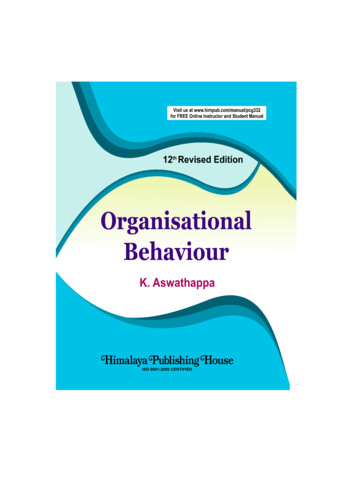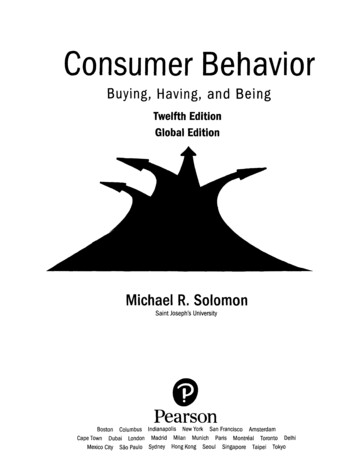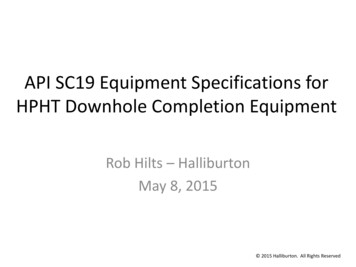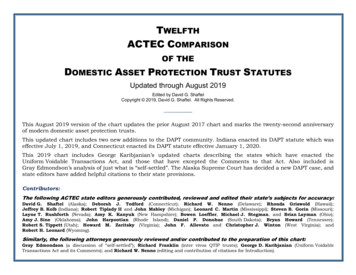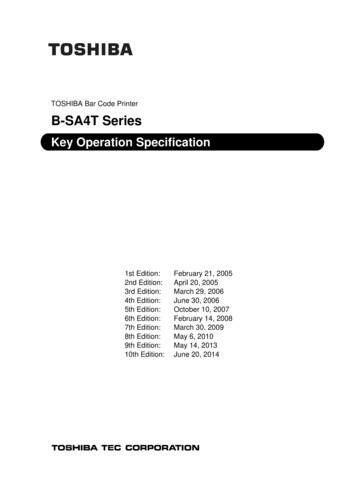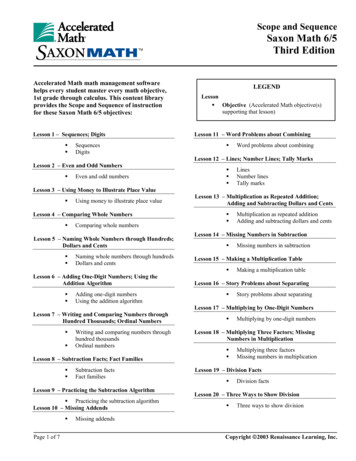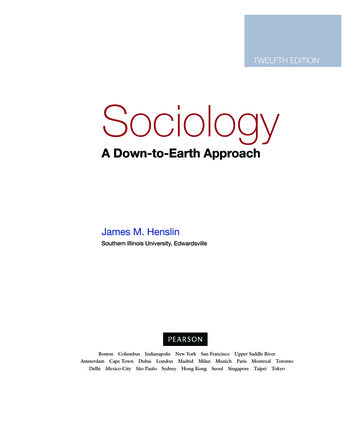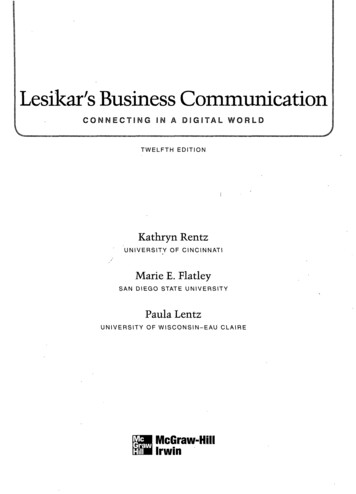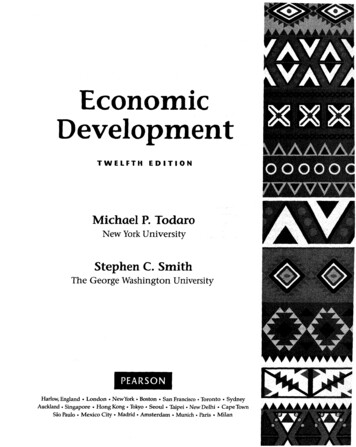
Transcription
EconomicDevelopmentTWELFTH EDITIONMichael P. TodaroNew York UniversityStephen C. SmithThe George Washington UniversityPEARSONHarlow, England London New York Boston San Francisco Toronto SydneyAuckland Singapore HongKong Tokyo Seoul« Taipei New Delhi CapeTownSäo Paulo Mexico City Madrid Amsterdam Munich Paris Milan
Brief ContentsPart OnePrinciples and Concepts 11 Introducing Economic Development: A Global Perspective2 Comparative Economic Development2403 Classic Theories of Economic Growth and Development1184 Contemporary Models of Development and Underdevelopment164Part TwoProblems and Policies: Domestic 2155 Poverty, Inequality, and Development2166 Population Growth and Economic Development: Causes,Consequences, and Controversies2847 Urbanization and Rural-Urban Migration: Theory and Policy3308 Human Capital: Education and Health in Economic Development3829 Agricultural Transformation and Rural Development43710 The Environment and Development49011 Development Policymaking and the Roles of Market, State,and Civil Society541Part ThreeProblems and Policies: International and Macro 59912 International Trade Theory and Development Strategy60013 Balance of Payments, Debt, Financial Crises, and StabilizationPolicies67814 Foreign Finance, Investment, Aid, and Conflict: Controversiesand Opportunities73115 Finance and Fiscal Policy for Development781
ContentsVAVAAVAVCase Studies and BoxesPrefacexixPart OnePrinciples and Concepts 1Introducing Economic Development: A Global Perspective2Prologue: An Extraordinary Moment1.1 How the Other Half Live2491.2 Economics and Development StudiesThe Nature of Development Economics 9Why Study Development Economics? Some Critical Questions 11The Important Role of Values in Development Economics 14Economies as Social Systems: The Need to Go Beyond Simple Economics 151.3 What Do We Mean by Development?Traditional Economic Measures 16The New Economic View of Development 17Amartya Sen's "Capability" Approach 18Development and Happiness 21Three Core Values of Development 22The Central Role of Women 24The Three Objectives of Development 241.4 The Future of the Millennium Development Goals1.5 Conclusions1624Case Study 1: Progress in the Struggle for More Meaningful Development: Brazil2830Comparative Economic Development402.1 Defining the Developing World2.2 Basic Indicators of Development: Real Income, Health, and EducationPurchasing Power Parity 45Indicators of Health and Education 492.3 Holistic Measures of Living Levels and CapabilitiesThe New Human Development Index 512.4 Characteristics of the Developing World: Diversity within CommonalityLower Levels of Living and Productivity 57Lower Levels of Human Capital 59Higher Levels of Inequality and Absolute Poverty 60Higher Population Growth Rates 6342455155Vll
Contentsviii2.52.62.72.8Greater Social Fractionalization 64Larger Rural Populations but Rapid Rural-to-Urban Migration 65Lower Levels of Industrialization and Manufactured Exports 66Adverse Geography 67Underdeveloped Markets 69Lingering Colonial Impacts and Unequal International Relations 70How Low-Income Countries Today Differ from Developed Countriesin Their Earlier StagesPhysical and Human Resource Endowments 74Relative Levels of Per Capita Income and GDP 75Climatic Differences 75Population Size, Distribution, and Growth 75The Historical Role of International Migration 76The Growth Stimulus of International Trade 78Basic Scientific and Technological Research and Development Capabilities 79Efficacy of Domestic Institutions 79Are Living Standards of Developing and Developed Nations Converging?Long-Run Causes of Comparative DevelopmentConcluding Observations Case Study 2: Comparative Economic Development: Pakistan and BangladeshAppendix 2.1 The Traditional Human Development Index (HDI)3 Classic Theories of Economic Growth and Development3.1 Classic Theories of Economic Development: Four Approaches3.2 Development as Growth and the Linear-Stages TheoriesRostow's Stages of Growth 120The Harrod-Domar Growth Model 121Obstacles and Constraints 123Necessary versus Sufficient Conditions: Some Criticisms of the Stages Model 1233.3 Structural-Change ModelsThe Lewis Theory of Economic Development 124Structural Change and Patterns of Development 129Conclusions and Implications 1303.4 The International-Dependence RevolutionThe Neocolonial Dependence Model 131The False-Paradigm Model 133The Dualistic-Development Thesis 133Conclusions and Implications 1343.5 The Neoclassical Counterrevolution: Market FundamentalismChallenging the Statist Model: Free Markets, Public Choice, and Market-Friendly Approaches 135Traditional Neoclassical Growth Theory 137Conclusions and Implications 1393.6 Classic Theories of Development: Reconciling the Differences Case Study 3: Schools of Thought in Context: South Korea and ArgentinaAppendix 3.1 Components of Economic GrowthAppendix 3.2 The Solow Neoclassical Growth ModelAppendix 3.3 Endogenous Growth 59
Contents4 Contemporary Models of Development and Underdevelopmentix1644.1 Underdevelopment as a Coordination Failure1654.2 Multiple Equilibria: A Diagrammatic Approach4.3 Starting Economic Development: The Big PushThe Big Push: A Graphical Model 176Other Cases in Which a Big Push May Be Necessary 181Why the Problem Cannot Be Solved by a Super-Entrepreneur 1824.4 Further Problems of Multiple EquilibriaInefficient Advantages of Incumbency 183Behavior and Norms 184Linkages 185Inequality, Multiple Equilibria, and Growth 1864.5 Michael Kremer's O-Ring Theory of Economic DevelopmentThe O-Ring Model 187Implications of the O-Ring Theory 1904.6 Economic Development as Self-Discovery4.7 The Hausmann-Rodrik-Velasco Growth Diagnostics Framework4.8 Conclusions168174 Case Study 4: Understanding a Development Miracle: China183187192193197200Problems and Policics: Domestic 215Poverty, Inequality, and Development5.1 Measuring InequalitySize Distributions 218Lorenz Curves 220Gini Coefficients and Aggregate Measures of Inequality 222Functional Distributions 224The Ahluwalia-Chenery Weifare Index (ACWI) 2255.2 Measuring Absolute PovertyIncome Poverty 2265.3 Poverty, Inequality, and Social WeifareWhat's So Bad about Extreme Inequality? 230Dualistic Development and Shifting Lorenz Curves: Some Stylized Typologies 232Kuznets's Inverted-U Hypothesis235Growth and Inequality 2395.4 Absolute Poverty: Extent and MagnitudeThe Multidimensional Poverty Index (MPI) 242Growth and Poverty 2485.5 Economic Characteristics of High-Poverty CroupsRural Poverty 250Women and Poverty 251Ethnic Minorities, Indigenous Populations, and Poverty 255216218226230240250
ContentsX5.6 Policy Options on Income Inequality and Poverty: Some Basic ConsiderationsAreas of Intervention 256Altering the Functional Distribution of Income through Relative Factor Prices 257Modifying the Size Distribution through Increasing Assets of the Poor 258Progressive Income and Wealth Taxes 260Direct Transfer Payments and the Public Provision of Goods and Services 2605.7 Summary and Conclusions: The Need for a Package of Policies256262 Case Study 5: Institutions, Inequality, and Incomes: Ghana and Cöte d'IvoireAppendix 5.1 Appropriate Technology and Employment Generation: The Price Incentive Model264272Appendix 5.2 The Ahluwalia-Chenery Weifare Index2755Population Growth and Economic Development:Causes, Consequences, and Controversies6.1 The Basic Issue: Population Growth and the Quality of Life6.2 Population Growth: Past, Present, and FutureWorld Population Growth throughout History 285Structure of the World's Population 287The Hidden Momentan of Population Growth 2916.3 The Demographic Transition6.4 The Causes of High Fertility in Developing Countries: The Malthusianand Household ModelsThe Malthusian Population Trap 296Criticisms of the Malthusian Model 301The Microeconomic Household Theory of Fertility 303The Demand for Children in Developing Countries 305Implications for Development and Fertility 3066.5 The Consequences of High Fertility: Some Conflicting PerspectivesIt's Not a Real Problem 308It's a Deliberately Contrived False Issue 309It's a Desirable Phenomenon 309It Is a Real Problem 311Goals and Objectives: Toward a Consensus 3146.6 Some Policy ApproachesWhat Developing Countries Can Do 316What the Developed Countries Can Do 318How Developed Countries Can Help Developing Countries with Their Population Programs 319 Case Study 6: Population, Poverty, and Development: China and India7Urbanization and Rural-Urban Migration: Theory and Policy7.1 Urbanization: Trends and Living Conditions7.2 The Role of CitiesIndustrial Districts 339Efficient Urban Scale 3437.3 The Urban Giantism ProblemFirst-City Bias 345Causes of Urban Giantism 346284284285293296307315321330331339344
Contents7.4 The Urban Informal SectorPolicies for the Urban Informal Sector 350Women in the Informal Sector 3547.5 Migration and Development7.6 Toward an Economic Theory of Rural-Urban MigrationA Verbal Description of the Todaro Model 358A Diagrammatic Presentation 360Five Policy Implications 3627.7 Conclusion: A Comprehensive Urbanization, Migration,and Employment Strategy Case Study 7: Rural-Urban Migration and Urbanization in DevelopingCountries: India and BotswanaAppendix 7.1 A Mathematical Formulation of the Todaro Migration Model8 Human Capital: Education and Health in Economic Developmentxi3483553573653693753828.1 The Central Roles of Education and HealthEducation and Health as Joint Investments for Development 384Improving Health and Education: Why Increasing Income Is Not Sufficient 3858.2 Investing in Education and Health: The Human Capital Approach3828.3 Child Labor8.4 The Gender Gap: Discrimination in Education and HealthEducation and Gender 396Health and Gender 398Consequences of Gender Bias in Health and Education 3998.5 Educational Systems and DevelopmentThe Political Economy of Educational Supply and Demand: The Relationship betweenEmployment Opportunities and Educational Demands 401Social versus Private Benefits and Costs 403Distribution of Education 4048.6 Health Measurement and Disease BürdenHIV/AIDS 412Malaria 415Parasitic Worms and Other "Neglected Tropical Diseases" 4188.7 Health, Productivity, and PolicyProductivity 420Health Systems Policy 422 Case Study 8: Pathways Out of Poverty: Progresa/Oportunidades in Mexico3913969 Agricultural Transformation and Rural Development3884014064204254379.1 The Imperative of Agricultural Progress and Rural Development4379.2 Agricultural Growth: Past Progress and Current ChallengesTrends in Agricultural Productivity 440Market Failures and the Need for Government Policy 4469.3 The Structure of Agrarian Systems in the Developing WorldThree Systems of Agriculture 448Traditional and Peasant Agriculture in Latin America, Asia, and Africa 449440448
xiiContentsAgrarian Patterns in Latin America: Progress and Remaining Poverty Challenges 451Transforming Economies: Problems of Fragmentation and Subdivision of Peasant Land in Asia 453Subsistence Agriculture and Extensive Cultivation in Africa 4569.4 The Important Role of Women9.5 The Microeconomics of Farmer Behavior and Agricultural DevelopmentThe Transition from Traditional Subsistence to Specialized Commercial Farming 462Subsistence Farming: Risk Aversion, Uncertainty, and Survival 462The Economics of Sharecropping and Interlocking Factor Markets 466The Transition to Mixed or Diversified Farming 468From Divergence to Specialization: Modern Commercial Farming 4699.6 Core Requirements of a Strategy of Agricultural and Rural DevelopmentImproving Small-Scale Agriculture 472Institutional and Pricing Policies: Providing the Necessary Economic Incentives 473Conditions for Rural Development 474 Case Study 9: The Need to Improve Agricultural Extension for Women Farmers: Kenya10 The Environment and Development10.1 Environment and Development: The Basic IssuesEconomics and the Environment 490Sustainable Development and Environmental Accounting 492Environment Relationships to Population, Poverty, and Economic Growth 493Environment and Rural and Urban Development 496The Global Environment and Economy 496Natural Resource-Based Livelihoods as a Pathway Out of Poverty: Promise and Limitations 498The Scope of Domestic-Origin Environmental Degradation 499Rural Development and the Environment: A Tale of Two Villages 500Environmental Deterioration in Villages 50110.2 Global Warming and Climate Change: Scope, Mitigation, and AdaptationScope of the Problem 502Mitigation 505Adaptation 50610.3 Economic Models of Environmental IssuesPrivately Owned Resources 508Common Property Resources 513Public Goods and Bads: Regional Environmental Degradation and the Free-Rider Problem 515Limitations of the Public-Good Framework 51710.4 Urban Development and the EnvironmentEnvironmental Problems of Urban Slums 518Industrialization and Urban Air Pollution 519Problems of Congestion, Clean Water, and Sanitation 52210.5 The Local and Global Costs of Rain Forest Destruction10.6 Policy Options in Developing and Developed CountriesWhat Developing CountriesCan Do 526How Developed Countries Can Help Developing Countries 528What Developed Countries Can Do for the Global Environment 529 Case Study 10: A World of Contrasts on One Island: Haiti and the Domlnican Republic458462471477490490502508518523526532
Contents11 Development Policymaking and the Roles of Market,State, and Civil Societyxiii54111.1 A Question of Balance54111.2 Development Flanning: Concepts and RationaleThe Flanning Mystique 542The Nature of Development Flanning 543Flanning in Mixed Developing Economies 543The Rationale for Development Flanning 54411.3 The Development Flanning Process: Some Basic ModelsThree Stages of Flanning 546Aggregate Growth Models: Projecting Macro Variables 547Multisector Models and Sectoral Protections 549Project Appraisal and Social Cost-Benefit Analysis 55011.4 Government Failure and Preferences for Markets over FlanningProblems of Plan Implementation and Plan Failure 554The 1980s Policy Shift toward Free Markets 556Government Failure 55711.5 The Market EconomySociocultural Preconditions and Economic Requirements 55811.6 The Washington Consensus on the Role of the State in Developmentand Its Subsequent EvolutionToward a New Consensus 56111.7 Development Political Economy: Theories of Policy Formulation and ReformUnderstanding Voting Pattems on Policy Reform 564Institutions and Path Dependency 566Democracy versus Autocracy: Which Facilitates Faster Growth? 56711.8 Development Roles of NGOs and the Broader Citizen Sector54211.9 Trends in Govemance and ReformTackling the Problem of Corruption 576Decentralization 578Development Participation 580 Case Study 11: The Role of Development NGOs: BRAC and the Grameen BankPart Three5465545585605625695765K3Problems and Policies: International and Macro 59912 International Trade Theory and Development Strategy60012.1 Economic Globalization: An IntroductionWO12.2 International Trade: Some Key IssuesFive Basic Questions about Trade and Development 606Importance of Exports to Different Developing Nations 608Demand Elasticities and Export Eamings Instability 610The Terms of Trade and the Prebisch-Singer Hypothesis 61012.3 The Traditional Theory of International TradeComparative Advantage 613 03612
ContentsRelative Factor Endowments and International Specialization: The Neoclassical Model 614Trade Theory and Development: The Traditional Arguments 61912.4 The Critique of Traditional Free-Trade Theory in the Contextof Developing-Country Experience6Fixed Resources, Füll Employment, and the International Immobility of Capital and Skilied Labor 620Fixed, Freely Available Technology and Consumer Sovereignty 623Internal Factor Mobility Perfect Competition, and Uncertainty: Increasing Returns, Imperfect Competitionand Issues in Specialization 624The Absence of National Governments in Trading Relations 626Balanced Trade and International Price Adjustments 627Trade Gains Accruing to Nationais 627Some Conclusions on Trade Theory and Economic Development Strategy 62812.5 Traditional Trade Strategies and Policy Mechanisms for Development:Export Promotion versus Import Substitution630Export Promotion: Looking Outward and Seeing Trade Barriers 632Expanding Exports of Manufactured Goods 635Import Substitution: Looking Inward but Still Paying Outward 637Tariffs, Infant Industries, and the Theory of Protection 637The IS Industrialization Strategy and Results 639Foreign-Exchange Rates, Exchange Controls, and the Devaluation Decision 644Trade Optimists and Trade Pessimists: Summarizing the Traditional Debate 64812.6 The Industrialization Strategy Approach to Export Policy651Export-Oriented Industrialization Strategy 651The New Firm-level International Trade Research and the Developing Countries 65512.7 South-South Trade and Economic Integration655Economic Integration: Theory and Practica 655Regional Trading Blocs, the Globalization of Trade, and Prospects for South-South Cooperation 65712.8 Trade Policies of Developed Countries: The Need for Reformand Resistance to New Protectionist Pressures659 Case Study 12: A Pioneer in Development Success through Trade: Taiwan66313 Balance of Payments, Debt, Financial Crises,and Stabilization Policies13.1 International Finance and Investment: Key Issues for Developing Countries13.2 The Balance of Payments AccountGeneral Considerations 679A Hypothetical Illustration: Deficits and Debts 68113.3 The Issue of Payments DeficitsSome Initial Policy Issues 685Trends in the Balance of Payments 68913.4 Accumulation of Debt and Emergence of the Debt Crisis in the 1980sBackground and Analysis 691Origins of the 1980s Debt Crisis 69313.5 Attempts at Alleviation: Macroeconomic Instability, ClassicIMF Stabilization Policies, and Their CriticsThe IMF Stabilization Program 695Tactics for Debt Relief 697678
Contents13.6 The Global Financial Crisis and the Developing CountriesCauses of the Crisis and Challenges to Lasting Recovery 707Economic Impacts on Developing Countries 710Differing Impacts and Continuing Challenges across Developing Regions 714Prospects for Recovery and Stability 717Opportunities as Well as Dangers? 718 Case Study 13: Trade, Capital Flows, and Development Strategy: South Korea14 Foreign Finance, Investment, Aid, and Conflict:Controversies and Opportunities14.1 The International Flow of Financial Resources14.2 Private Foreign Direct Investment and the Multinational CorporationPrivate Foreign Investment: Some Pros and Cons for Development 736Private Portfolio Investment: Benefits and Risks 74314.3 The Role and Growth of Remittances14.4 Foreign Aid: The Development Assistance DebateConceptual and Measurement Problems 747Amounts and Allocations: Public Aid 748Why Donors Give Aid 750Why Recipient Countries Accept Aid 754The Role of Nongovernmental Organizations in Aid 755The Effects of Aid 75614.5 Conflict and DevelopmentThe Scope of Violent Conflict and Conflict Risks 757The Consequences of Armed Conflict 758The Causes of Armed Conflict and Risk Factors for Conflict 761The Resolution and Prevention of Armed Conflict 763 Case Study 14: Costa Rica, Guatemala, and Honduras:Contrasts and Prospects for Convergence15 Finance and Fiscal Policy for Development15.1 The Role of the Financial System in Economic DevelopmentDifferences between Developed and Developing-Country Financial Systems 78415.2 The Role of Central Banks and Alternative ArrangementsFunctions of a Full-Fledged Central Bank 787The Role of Development Banking 79115.3 Informal Finance and the Rise of MicrofinanceTraditional Informal Finance 792Microfinance Institutions: How They Work 793MFIs: Three Current Policy Debates 796Potential Limitations of Microfinance as a Development Strategy 79815.4 Formal Financial Systems and ReformsFinancial Liberalization, Real Interest Rates, Savings, and Investment 799Financial Policy and the Role of the State 801Debate on the Role of Stock Markets 803XV706720731731732744747757767781782787792799
Contents15.5 Fiscal Policy for DevelopmentMacrostability and Resource Mobilization 805Taxation: Direct and Indirect 80515.6 State-Owned Enterprises and PrivatizationImproving the Performance of SOEs 811Privatization: Theory and Experience 81215.7 Public Administration: The Scarcest Resource Case Study 15: African Success Story at Risk: BotswanaGlossary826Name Index839Subject Index851
4 Contemporary Models of Development and Underdevelopment 164 4.1 Underdevelopment as a Coordination Failure 165 4.2 Multiple Equilibria: A Diagrammatic Approach 168 4.3 Starting Economic Development: The Big Push 174 The Big Push: A Graphical Model
